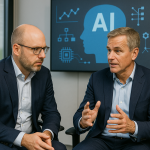Last week, I had the chance to join Martin Meller from Accenture in an energizing session title AI as a Leadership Tool. And if there’s one thing that resonated deeply, it was this: AI won’t replace leaders. But it will replace outdated leadership models.
This isn’t a catchy soundbite. It’s a call to fundamentally rethink how we define leadership in the AI-powered world.
The Myth of Replacement: AI and Leadership
There’s a persistent fear across industries: “Will AI take my job?” But when it comes to leadership, the real threat isn’t AI replacing humans. It’s AI exposing outdated ways of working—and making them obsolete.
Martin Meller put it well: “Agentic AI won’t replace leaders. But it will replace old models of leadership.” In other words, AI doesn’t remove the need for leaders. It redefines what leadership needs to be.
Traditional leadership is rooted in control, predictability, and hierarchy. But in a world where AI can simulate, adapt, and decide faster than we can schedule our next strategy meeting, control becomes a bottleneck, not a strength.
The New Leadership Profile
So what does leadership look like now?
It looks like visionaries who can zoom out and see possibilities that connect technology, people, and business.
It looks like generalists who can work across silos, understand patterns, and translate between tech teams and business needs.
It looks like iterators who aren’t afraid to launch, learn, and pivot—because learning velocity now beats perfection.
This new breed of leader thrives in ambiguity. They understand that intelligence, whether human or artificial, needs space to experiment, fail fast, and improve. They focus less on being the smartest person in the room and more on designing systems where smart people (and smart machines) can co-learn.
AI-Literate Leaders: Why Curiosity Beats Control
You don’t need to be an AI expert. But you do need to lead AI.
That means:
- Understanding how decisions are being made—by humans and machines
- Knowing where algorithms are acting on your behalf, and if they align with your values
- Creating feedback loops that keep models accountable and evolving
Leadership in the AI age isn’t about controlling every decision. It’s about knowing what decisions can (and should) be delegated—and then designing the guardrails for those decisions.
This is what Martin called the move from command and control to code and consequence. Leaders must now ask: How can I scale my leadership through algorithms, without losing culture, values, or intent?
From Command & Control to Code & Consequence
Most organizations today still operate in structures built for a pre-AI world. We have the tools—but we haven’t redesigned how we work.
We cling to micromanagement, linear approvals, and narrow KPIs. But AI systems thrive on autonomy, context, and pattern recognition.
That’s why the best leaders today focus on:
- Designing workflows that empower teams and AI agents to co-create
- Curating knowledge ecosystems where data, humans, and machines collaborate
- Embedding values into algorithms so leadership scales with integrity
This shift requires humility. You’re not just leading people anymore. You’re leading a hybrid workforce of humans and intelligent agents.
The Strategic Risk of Ignoring AI
There’s a price to be paid for staying comfortable. Innovation debt. Missed signals. Cultural stagnation.
As the Accenture presentation framed it: “Ignorance isn’t passive. It’s a strategic risk.”
Choosing not to engage with AI isn’t neutral. It’s a decision—and one with serious consequences. Leaders who delay or delegate their AI fluency will soon find themselves making slower, less-informed decisions while their competitors simulate, test, and optimize in real time.
We are already seeing it:
- AI systems helping retailers like Shein adapt to trends in real time
- Internal AI agents detecting stress patterns in employee communication
- AI-enabled CRMs delivering “next best actions” that boost sales productivity by 20%
These aren’t science fiction. They’re operational realities. And if you’re not engaging with this shift, you’re falling behind—faster than ever before.
My Reflection: The Generalist Advantage
What resonated most for me during this session with Martin was how aligned our perspectives were. We both believe that the AI era calls for generalist leaders who:
- See across domains
- Thrive on iteration
- Value speed over perfection
- Understand how to turn complexity into clarity
We don’t need more AI experts. We need more leaders who can see patterns, translate value, and build adaptive systems.
And we need leaders who have the courage to rethink their posture. Not just adopt tools. But adopt a mindset where intelligence (human or artificial) is empowered to thrive.
Conclusion: It’s Not About AI. It’s About Leadership.
Let’s be clear: AI doesn’t replace leadership.
It replaces the illusion that leadership is a matter of personal capacity or charisma.
In this new era, leadership is a multiplier. It’s about how many decisions you influence without being in the room. How many systems you design that make good choices, even when you’re offline.
That’s what real scale looks like. That’s what modern leadership demands.
So I’ll leave you with the question I’m still asking myself:
What decisions am I still making that AI could support—or challenge?
Because if we want to lead in the future, we need to start leading the future.











